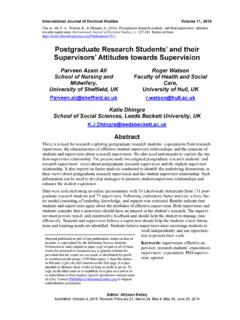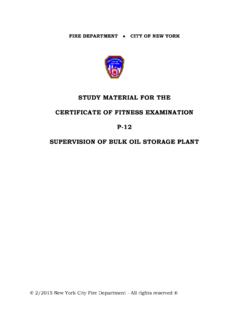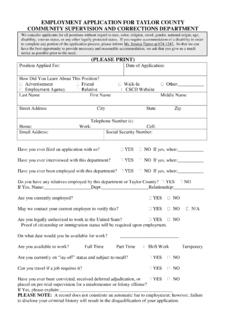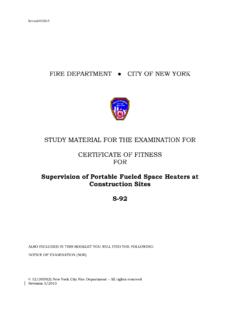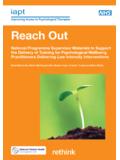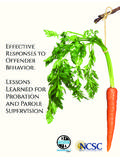Transcription of Practices in Peer Specialist Supervision and Employment
1 NJPRA November 17-18, 2010 Conference title: Living the values of recovery in policies, programs, and practice Peggy Swarbrick & Pat Nemec 1 Practices in peer Specialist Supervision and Employment peer specialists play an increasingly important role in a recovery-oriented service system, yet there are no accepted national standards for defining this role or the essential competencies on which to base training and certification programs. This presentation will provide an up-to-date summary of best Practices for peer Specialist Supervision and Employment based on foundation principles, research, and practical experience. Objectives At the end of the workshop, participants will be able to: 1.
2 Identify the key competencies of the peer Specialist role 2. Explain the concept of universal design as applies to Employment policies 3. Suggest personnel policies that would effectively support peer staff In a recent study, written peer job descriptions .. showed that the expectations of peers were often unreasonable and greatly exceeded the formal specified job responsibilities. * (p. 298). The study authors recommend: 1) Hiring policies that are responsive to the unique qualifications of peers such as accepting experience in lieu of formal credentials; 2) A job structure that conveys the importance of peers to the agency, including positions that are permanent and independent of changing levels of funding, compensated and evaluated on the same performance standards as non- peer staff, and provide opportunities for advancement; 3) HR Practices that help peers participate in the workplace to the fullest extent possible; 4) Orientation and training to all constituencies about the peer role.
3 And 5) Clear communication of the value of peers in a mission statement that supports recovery, a strong leadership role in supporting the mission, and formalized opportunities to learn about policies and Practices such as a mandatory new employee orientation. *Gates, L. B., & Akabas, S. H. (2007). Developing strategies to integrate peer providers into the staff of mental health agencies. Admin Policy in MH and MH Services Research, 34, 293-306. Quote is from p. 298) Universal Design The design of products and environments to be usable by all people, to the greatest extent possible, without the need for adaptation or specialized design. The Center for Universal Design NC State University Human resources policies based on universal design are: Simple, intuitive, easy to understand Equitable and relevant to all employees Affordable and included in the budget Designed to minimizes misuse / abuse Flexible enough to accommodate a wide range of needs Developed by involving stakeholders in design and evaluation NJPRA November 17-18, 2010 Conference title: Living the values of recovery in policies, programs, and practice Peggy Swarbrick & Pat Nemec 2 The Job Description A job description provides a summary of the primary duties, responsibilities, and qualifications of a position.
4 It is important to reflect priorities and current expectations. Components of the job description: Function: Summarize the main purpose of the position within the department/organization in one sentence. Reporting Relationships Describe the chain of command and the types of Supervision the employee will get and will give, indicating the specific job titles of the supervisors and the positions supervised. Responsibilities List 4 to 6 core responsibilities of the position and identify several specific duties within each of the core responsibility areas. Qualifications/Competencies List required and preferred qualifications, credentials, and competencies in order of importance. These might include educational requirements ( , a high school diploma or equivalency), training or certification as a peer Specialist , or specify that the employee must be a person in recovery ( Be a self-identified current or former user of mental health or co-occurring services who can relate to others who are now using those services or Must be a self-disclosed individual with a mental illness) Employment Conditions Describe any relevant circumstances, such as any physical requirements ( , standing, lifting), environmental conditions, unusual work schedule ( , rotating shift, on-call hours), and any other requirements ( , driver s license, background check, random drug screen)
5 Tips from the Small Business Association ( ): A good job description begins with a careful analysis of the important facts about a job, such as tasks involved, methods used to complete the tasks, and the relationship of the job to other jobs. It s important to make a job description practical by keeping it dynamic, functional, and current. Don t get stuck with an inflexible job description! A poor job description will keep you and your employees from trying anything new and learning how to perform their job more productively. A well-written, practical job description will help you avoid hearing a refusal to carry out a relevant assignment because it isn t in my job description. NJPRA November 17-18, 2010 Conference title.
6 Living the values of recovery in policies, programs, and practice Peggy Swarbrick & Pat Nemec 3 Sample peer Specialist Job Description Components* Sample function statements Provide vision driven hope and encouragement to support people in their recovery and assist them in connecting to the community Provides opportunities for individuals receiving services to direct their own recovery process (self-determination) and acts as an advocate for the needs and rights of persons served Works with individuals in groups and on a one-to-one basis to provide recovery training and outreach to individuals who use mental health services in the community Shares personal recovery experiences and develops authentic peer -to- peer relationships Offers instruction and support to help people develop the skills they need to facilitate their recovery Informs people served of available service options and choices while promoting the use of natural supports and resources within the community Supports people to articulate and describe their needs, wants and desires to providers and family members (self-advocacy)
7 Provides peer mentoring and support for individuals with psychiatric disabilities receiving mental health services Assists individuals in navigating the mental health services system and in achieving resiliency and recovery as defined by the person Sample responsibility statements Assist in the orientation process for persons who are new to receiving mental health and/or co-occurring disorders services Educate and support people in the use of Wellness Plans, including Wellness Recovery Action Plan, as a means to recognize early triggers and signs of relapse, and use of individual coping strategies as an alternative to more restrictive services Outreach/accompany to ensure the individual is making a successful transition to community integration and is continuing their progress toward recovery goals Support the individual in seeking to connect/reconnect with family, friends, significant others and in learning how to improve or eliminate unhealthy relationships Provide education and advocacy within the community that promotes awareness of psychiatric disorders while reducing misconceptions, prejudice, and discrimination Keep treatment team informed about individual s strengths.
8 Accomplishments and obstacles in relation to their recovery goals Complete all required documentation in a timely, legible manner Educate professional staff about the recovery process and the damaging role that stigma can play in undermining recovery Visit community resources with people using services to assist them in becoming familiar with potential opportunities Facilitate (via personal coaching and WRAP groups) the transition from a professionally directed service plan to a self-directed Recovery Plan Model personal responsibility, self-advocacy, and hopefulness through telling one s personal recovery story, how needs are respectfully met, and how a belief in oneself is maintained Ensures confidentiality of individual information Assess emergency situations, notifies supervisor and/or appropriate clinical and administrative personnel of actual or potential problems Exhibits a nonjudgmental approach, effective listening, good eye contact, and positive interactions *adapted from job descriptions and materials from Pennsylvania, North Carolina, Recovery Innovations of Arizona.
9 Florida peer Network Inc., the Transformation Center (Boston, MA), and Collaborative Support Programs of NJNJPRA November 17-18, 2010 Conference title: Living the values of recovery in policies, programs, and practice Peggy Swarbrick & Pat Nemec 4 Training Pre-Service New Employee Orientation On-the-job Training Continuing Ed Our most common approaches to instruction, involving top-down teaching through a lecture format, have little impact on a clinician s behavior and essentially no effect on healthcare outcomes. * A competency is the ability to apply or using knowledge, skills, attitudes, and personal characteristics to successfully perform critical work tasks, specific functions, or operate in a given role or position (Ennis, 2008).
10 The Competency Model Clearinghouse identifies tiers of competencies that can be applied to understanding the job requirements for peer specialists : peer specialists (Occupation-Specific) Recovery-Oriented Services (Industry Specific: All Workers) Mental Health Services (Industry-Wide: All Workers) Basic Workplace Skills Basic Academic Skills Basic Personal Effectiveness Skills Adapted from the interactive graphic: Most employees need and get some level of mentoring when starting a job. Some of this is provided by the supervisor, some by line colleagues, and some by non-direct colleagues with whom the employee finds an allegiance. In some settings, a staff member may be assigned to focus on training new personnel.

